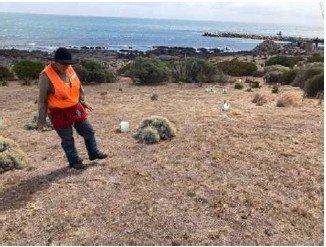Cape Jervis Coastal Community Group
WORKING BEE REPORT February 7-9, 2025
Whenever there is a break in the standard pattern of our working bees, it usually means some of our very loyal volunteers can’t make it…the first weekend of every “even” month is pencilled in our mental calendars before the start of the year, and other plans made around them. So we try hard to stick to our pattern, and have only moved working bees twice, and cancelled because of heat once. However this working bee was a week later than normal, so we fully expected just a small group of vollies. Luckily, being late summer we were not planning any major tasks like planting, brushcutting, moving logs and rocks, etc…just some weeding, watering and “cleaning up”. In Carolyn’s words, “cruisey”!
FRIDAY, February 7
One of the site inspection tasks on the Friday was to check up on the growth of the 2023/24 tubestock on the lower loop. This area is a pretty hostile environment, with high velocity salt winds and full sun. Add to that the drought this year, and it amounts to poorer growing conditions than normal. As you can see from the photos below, theground is brown and dry. However, a surprising number of the plants in the treeguards have survived, and in many cases, thrived. So there was one job set for the weekend: remove these tree guards!
The plantings shown are on the western side of the Heysen Trail/Wild South Coast Way, near the water’s edge. In between the plantings and the water’s edge is a slight drop, down to the rocks. We are planning a path down from the plantings to the rocks, marking it out on previous working bees. We checked it out again, and decided we need help to get it done properly. If anyone has any trail making experience, cutting steps into a slope, hello! We’d welcome your input!! We need to find time to contact the Friends of the Heysen Trail as they have indicated they might be able to help. Another thing for the to do list!
Some brushcutting had been done on site, reducing the scabiosa seed heads in the “grasslands” section…hurrah, one job OFF the list of tasks for the working bee, for this part of the site. Brushcutting was part-funded by Landcare SA, and the remainder from the “Para Land sale community fund”. In the words of our great contractors – it’s a very “technical job” (aka time-consuming = expensive, $$$), because there are so many tree guards and plants to brush cut around, native grasses and ground covers to distinguish from the weeds. Thankfully there were less weeds than in Spring, so the allocated funds meant the drain got brushcut too. Brush cutting in habitat restoration projects is expensive, but helps with plant establishment, natural recruitment (self seeding) and makes a huge difference to the amenity of the site.
Despite some plants doing really well even in drought conditions, some are really struggling. These are mainly our “small pretties”, things like the native pelagoniums, goodenias, lotus, etc. Unfortunately, some of the banksia are also suffering, in fact one was terminal and yet a second one planted the same year ( 2018?) was thriving. The healthy one had a nearly mature seed pod (that was harvested a couple of weeks later as some of the fruit opened). The same plant was flowering again mid-March! The two plants were less than 2 m apart so it is hard to know why one thrived and one died! Seeding banksias are exciting because there are not many Banksia marginata plants left along the coasts of on the southern Fleurieu, with the seed for our projects coming from just four plants from the Lands End revegetation project.
The Friday afternoon tour continued walking from the lower loop to the south east corner of the site to check out the Rapid Bay Primary School plantings at the Fleurieu Ave/Sorata St corner (we need a better name for that area!). We seem to be having trouble with tree guards this year. See photos below of some typical examples. These “re-used” guards had been used about 6 - 8 months in the previous year, before being cut, and reused in April 2024. Many are just breaking apart and others are turning to dust (if you zoom in on the two right hand photos below you can see the other layer is breaking up).
Is anyone else having issues like this? See our next working bee report (April 2025) for our current years plan to test some different tree guards.
Saturday, February 8
This was the “cruisey” day Carolyn promised! We began at the coast end of Sorata Street to do some watering, including the cages. Jane beat us there and did a self guided tour of the lower loops telling us how fabulous it looked! Well done team. Jane was happy weeding scabiosa while Liz and Carolyn watered. The soil there is quite sandy and with the extending dry, we decided to add liquid soil wetter to the watering can (for the orchids), and the tubs for all the other plants.
Sue and Greg, soon joined Jane, Carolyn and Liz and we met them at the car for a quick chat and gear check. Liz and Carolyn routinely wear snake gaters on site, and we noticed that the ones Sue was putting on were different to ours. Newer model by the same company, but with some useful design features. Adjustable straps top and bottom to help them stay up.
Watering and weeding continued, doing whichever weeds took their fancy, using whichever tools worked for them: choose your patch, choose your weeds and go for it! It was actually very therapeutic, having a day of removing whatever weeds offended us each the most. It is interesting how everyone has their favourite plants but also their “favourite” weeds, ones they detest the most. Liz for instance really dislikes onion weed (not many in today’s area) and olives (plenty of them to be pinned!). For Carolyn it’s olives, cyclops and scabiosa. The scabiosa hadn’t been brush cut in this area. Look at the difference between here and the lower loop earlier. Greg did a great job, though, digging a lot of rosettes out!
You can see how sad some of the plants look. On the left is Lotus australis, and theright one of our newly planted Banksia plants. Sadly none of the three Banksia plants planted here in 2024 survived through to the end of March.
We had a late more tea – and clearly we were expecting tens of volunteers with the choice provided. Date, nut and ginger balls (vegan), cherries, raspberry cheesecakes, apple cheesecake, and a carrot cake (?). Yum.
Then after sustenance, we decided to do a walk and weed through the best remnant patch. Hand pulling and loppering cyclops and tree popping or pinning olives. The ground is so dry, and the roots weak, that Greg was able to remove lots of small olive seedlings. Bigger plants were pinned for poisoning later by us or a contractor. We must have put out about 50 pins!
We also had a “new” find, a Hakea rostrata (beaked hakea) seedling. There are only a few records of this species around the Cape. A hiding cyclops was already seeding – grrrr. How did we miss it? Scabiosa is creeping into this patch. You can see the seed heads (below right), on the edge of a kangaroo highway – this is how the invasion starts. Must get on top of these before they really get out of control!
Sunday, February 9
It was an early start for Carolyn and Liz, who began the day watering in “the drain”. This runs diagonally from the north-east corner of our site, for several hundred metres. In the first couple of years of our group’s existence, we spent quite a bit of time removing olives, phalaris, rice millet, kikuyu and other weeds from this stretch. However, of recent years it has fallen to Carolyn to maintain this bit.
Recently, it was brush cut, and Carolyn was keen to show some of her innovations there. One of the ideas she has been trialling is using old hessian sacks filled with old native potting mix as erosion control measures in the drain. After positioning the filled sack in the drain, she pokes a hole or two in it, and inserts a small plant in each hole. Because it is a drain, there is more water there over winter, so the sacks often stay moist giving the plants a good head start. (Over a dry summer like this one, a bit of supplementary water is needed, but that is true just about everywhere on site.)
Greg and Sue joined us at the drain, spotting our cars as they drove past. And just because it’s pretty…look at this melaleuca flowering (Melaleuca lanceolata, dryland tea-tree). Dry weather or not, what a magnificent display! An important nectar source in our dry summers, being visited by a “bristle fly” and many other insects. After checking out the progress, we moved to the lower loop. Not so easy getting in anymore. Roll and June and hopefully we will be able to drive in again without going through three sets of gates!
Those tree guards that we had eyed off for removal were the order of business for the morning. What a difference it made when they went!
An unknown plant? or a mutant Acrotriche cordata?
The week before the working bee, Carolyn was “cyclopsing” and poisoning small olives when she spotted an unknown plant, just off the Heysen Trail, south of the reserve. It looked a bit like Acrotriche cordata, which grows nearby, but was more compact. A check of It’s Blue with Five Petals (by Ann Prescott), and a post on SA Natureteers did not provide any new candidates, so Liz and Carolyn went back on the Friday to compare the “new” plant (middle photo, left plant), with a piece of A. cordata (middle photo, right plant).
The leaves of Acrotriche species are quite distinctive with different arrangements of hairs, veins and even how they are attached to the stem. Ann Prescott’s beautiful drawing illustrate these differences. We will have to go back when the plants are flowering to see if was can resolve this mystery.
Creating habitat for our furry friends
Small jumping spiders seem to love are tree guard, but are hard to photograph, as they are not happy when disturbed with a shower of water. Other spider just “freeze” in place as seen here with this huntsman found when removing treeguards and an orbweaver found while watering, hidden in the leaves of Pomaderris paninculosa. This older joey was disturbed while collecting stakes from one of our old plantings along Flinders Drive, hiding in the shade. They are doing it tough out there
Stressed plants are more susceptible to pests
One of the other things you notice when out watering is the plants that are under attack from various bugs, including scales. Here’s a few we have noticed between working bees. Can you spot the ants visiting the scale in the right hand photo?




















































